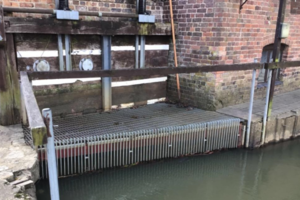Severn flood defences undergoing thorough checks
Environment Agency is checking hundreds of flood assets to make sure they are fully operational and ready to protect against flood risk.

Essential work underway to maintain defences in top condition
- Essential work happening to maintain defences in top condition
- Thousands of properties protected from devastating impact of flood defences during storms
The Environment Agency is carrying out inspections and maintenance to flood defences along the River Severn following the February storms when the defences were in operation providing benefit to thousands of homes and businesses.
Storms Dudley, Eunice and Franklin hit the UK in February, seeing the Met Office issue 2 rare red warnings for Eunice which was the most severe and damaging storm to affect England and Wales for many years.
A forecast tidal surge on the Severn Estuary threatened flooding to thousands. This was followed by heavy rainfall in the Welsh Mountains which saw the River Severn rise to extremely high levels in its upper reaches resulting in flooding of some properties in the area.
Rhys McCarthy, Flood Risk Manager for the Environment Agency said:
February brought 3 named storms in succession which posed a significant risk of flooding to communities along the River Severn. We were however prepared, with thousands of properties benefiting from the protection that our defences provided. These defences included flood walls and embankments, flood storage areas, temporary barriers, property flood resilience measures, pumps and flood gates.
We are now inspecting all of our flood defences to work out where any essential repair works are needed to make sure they are all in good working order and fully operational, ready to use again. This work includes removing any blockages in rivers and culverts, clearing debris from trash screens and checking the operation of sluices. Demountable and temporary defences and pumps have already been cleaned and checked for damage.
The Environment Agency issued 12 severe flood warnings and a total of 118 flood alerts and warnings during the storms and deployed all of its flood assets along the Rivers Severn and Wye, including temporary and demountable barriers at Shrewsbury, Ironbridge, Hereford and Bewdley.
Flooding can have a devastating impact, which is why protecting people and communities is the Environment Agency’s top priority. It is clear that we are already seeing the impacts of climate change in the UK and around the world, which is why urgent action is needed to adapt the impacts of climate emergency at the same time as reducing emissions.
Community teams from the Environment Agency, Worcestershire County Council, Shropshire Council, the National Flood Forum, Severn Trent Water and district councils have also been out speaking to communities throughout Worcestershire and Shropshire.
Anyone can sign up for free flood warnings and take action to make sure they know what to do in case of flooding.
You can check your flood risk, sign up for free flood warnings and keep up to date with the latest situation at GOV.UK, call Floodline on 0345 988 1188 or follow @EnvAgency on Twitter for the latest flood updates.
Notes to editors
- Over a 9 day period from 12 to 20 February 2022, more than 100 millimetres of rain fell widely across upland areas, and 200 millimetres across parts of Wales. Much of Wales and northern England received the whole-month February 1991-2022 average rainfall, with some locations more than 150% of average.
- Flooding to property can occur directly and indirectly from the River Severn. Indirect flooding can occur due to rising groundwater with cellars filling with water, and from surface water and sewers when the rise in river level means the sewers cannot discharge to the River Severn.
- As part of our management of flood risk on the River Severn we consider a range of options in terms of actions to reduce flood risk and increase flood resilience, this includes construction of flood protection schemes such as those in Bewdley and Upton-Upon-Severn, enhanced maintenance of the River Severn clearing blockages and removing debris, tree work, weed cutting, maintenance of earth embankments, preventing in appropriate development in the floodplain. When considering options for reducing flood risk we have to look at a number of factors such as overall benefit, cost and impact on the environment.